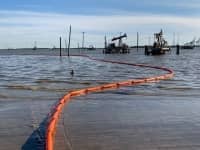There are many ways to protect sensitive locations from the advancing oil-slick during a response to a spill. Using a containment boom is one common method. Booms are floating barriers to oil made of metal, plastic or other materials that slow down the spread and contain it. Skilled workers deploy booms using mooring devices such as anchors, land lines, and landlines. Texas Boom Company makes oil spillage containment booms, which can be used in many different situations. Our containment booms have a reputation for being durable, reliable, and easily accessible. Texas Boom offers a variety of oil containment booms depending on the situation. Our top-quality materials include encapsulated closed cell foam flotation, galvanized chains ballast, coated or sleeves stainless steel top tension cables (where appropriate) and industry-standard ASTM aluminum end connectors.
It is crucial to respond quickly in the event of an oil spillage, whether it be inland or offshore. This will protect both sensitive resources as well as the environment. It can take several hours, if not days, to reach the spillage site and to deploy the equipment necessary to stop it from growing further and redirect it towards a collection point. It is possible to significantly alter the outcome of an oil leakage by having equipment like oil spill containment booms available. A floating barrier that is used to contain oil spillages on water is called an oil spillage containment boom. A containment boom usually consists of an above-water floating barrier or "freeboard" that contains the oil and prevents it from splashing onto the boom. It also includes a weighted skirt, or "draft", to reduce oil loss underneath the boom. To connect booms together, couplings are required at least on one end. This allows for unlimited boom length and helps to contain the spillage. Although some booms can absorb oil and help to contain it, they are not designed to clean up oil spillages. A containment boom's purpose is to stop the oil from leaking and diverting it to a collection site. Multiple containment booms can be linked end-to-end to prevent larger oil spillages. One or more vessels may then pull the multiple containment booms. A large reel attached to a vessel may be used to deploy fence booms. These booms have flat freeboards rather than rounded curtain booms. Booms can be attached to mooring points in rare instances. This is because it is impossible to place multiple moorings during an emergency. 
Oil spillage booms can be very effective and almost necessary in the event of an oil spillage. However, it is crucial that the right type of boom is used for the specific application. A high-tensile boom will be required to withstand currents and waves in fast-moving water environments like rivers and intertidal zones. A lighter-weight fence boom is possible in calmer waters like ditches and streams. Performance of the containment boom should be monitored, not assumed. Droplets will rise from the boom's boom if oil is lost. Booms can also bend, sink, or twist under the waterline, which allows oil to escape from the containment area. This can happen for many reasons, but it is most often due to tidal conditions or improper deployment. For over 35 years, Texas Boom has been manufacturing a wide range of equipment to support the oil spill response and prevention industries. You can trust that Texas Boom will point you in the right direction and will assist you in clearing oil spills.






